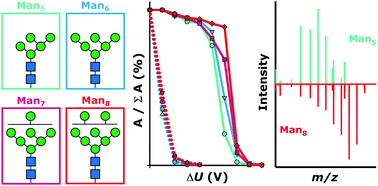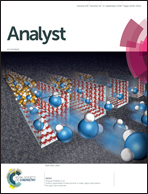Precursor ion survival energies of protonated N-glycopeptides and their weak dependencies on high mannose N-glycan composition in collision-induced dissociation†
Abstract
Fully realizing the capabilities of tandem mass spectrometry (MS/MS) for analysis of glycosylated peptides will require further understanding of the unimolecular dissociation chemistry that dictates their fragmentation pathways. In this context, the overall composition of a given glycopeptide ion is a key characteristic; however, the extent to which the carbohydrate moiety influences the preferred dissociation channels has received relatively little study. Here, the effect of glycan composition on energy-resolved collision-induced dissociation (CID) behavior was studied for a select menu of 30 protonated high mannose type N-linked glycopeptide ions. Groups of analytes which shared a common charge state, polypeptide sequence, and glycosylation site exhibited 50% precursor ion survival energies that varied only slightly as the size and composition of the oligosaccharide was varied. This was found to be true regardless of whether the precursor ion survival energies were normalized for the number of available vibrational degrees of freedom. The practical consequence of this was that a given collision energy brought about highly similar levels of precursor ion depletion and structural information despite systematic variation of the glycan identity. This lack of sensitivity to oligosaccharide composition stands in contrast to other physicochemical properties of glycopeptide ions (e.g., polypeptide composition, charge state, charge carrier) which sharply influence their energy-resolved CID characteristics. On the whole, these findings imply that the deliberate selection of CID energies to bring about a desired range of fragmentation pathways does not necessarily hinge on the nature of the glycan.



 Please wait while we load your content...
Please wait while we load your content...